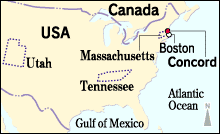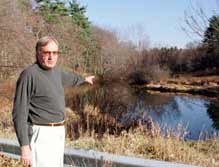| The penetrators in the DU shells that the
US military first used in combat in the Gulf
War were produced by two munitions factories
in Massachusetts and Tennessee. These radioactive
weapons used by the US overwhelmed the Iraqi
tanks. However, through radiation exposure
and chemical toxicity, these same weapons
also seriously impaired the health of US
soldiers. The effects of radioactive pollution
on the environment and on human bodies have
cast a dark shadow on the residential communities
near these production sites.
(Story and photo by Akira Tashiro, senior
staff writer)
|
| Polluting factory near residential area Disposal in the ground for 40+ years |
I found Starmet Corporation, manufacturer
of DU penetrators, about 30 kilometers (about
19 miles) northwest of Boston, Massachusetts,
in the southwest tip of Concord, the historic
town that launched the American Revolution.
Concord's population is about 18,000, and
Starmet is one of several factories located
in a quiet, wooded, otherwise residential
area.
"The state government has designated
this factory one of the state's most toxic
waste disposal sites." Jack Scotnicki
(57), a volunteer teacher who was my guide
that day, talked as he turned his car into
the road leading to the factory. "
For decades, DU sludge and polluted water
were dumped into the holding basin and marshland
behind the factory, and DU particles emitted
by the smokestacks."
![]() The drinking water in the suburbs
The drinking water in the suburbs
A major road runs in front of the factory,
which stands on a small hill. Beyond the
road flows the Assabet River. Parking the
car on a side road next to the river, Scotnicki
said, "This river provides the drinking
water for Billerica, Massachusett, a town
that lies downstream. If this were contaminated,
we would be in serious trouble." His
expression was grim as he looked at the river.
Starmet Corporation was founded in 1958 as
Nuclear Metals Inc. (NMI). The original leaders
of Nuclear Metals, Inc. were professors at
nearby Massachusetts Institute of Technology
(MIT). They researched methods of using depleted
uranium (U-238), a radioactive waste product
generated in the nuclear weapon production
process. Former President John F. Kennedy,
then a US senator, helped celebrate the founding
of this company by attending its opening
ceremony.
"At first, the company was also researching
uranium 235, a fissile material. We know
this because uranium 235 has been detected
in the waste," said Scotnicki.
![]() No shield for the holding basin
No shield for the holding basin
Full-scale production of DU penetrators to
fulfill a military contract began in the
1970s. At its peak in the 80s, the company
had more than 600 employees. NMI's focus
was on raising production. The liquid radioactive
waste it generated in the process was summarily
dumped on site into a natural kettle hold
in the ground. Referred to as a "holding
basin," the radioactive sludge pit lacks
even a concrete lining. By 1985, more than
181 tons of DU, 317 tons of copper, and upwards
of 360 kilograms of uranium 235 had been
dumped into that hole.
![]() Investigation by local residents
Investigation by local residents
"Can you believe it?" Scotnicki
raised his shoulders in an exaggerated gesture.
"These facts began to come out when
local residents started a environmental study
of NMI in 1989."
Seeking to alter its image, NMI changed its
name in 1997. By September 1998, under the
guidance of the state Department of Environmental
Protection and with $6.5 million provided
by its contract partner, the US Army, the
newly named Starmet Corporation had spent
$8.2 million to remove roughly 6,100 cubic
meters of sludge from the basin and transport
it to a low-level radioactive waste storage
facility in Utah.
"It was too late," said Scotnicki.
The polluted water that seeped from the highly
toxic radioactive sludge had already polluted
the surrounding soil and underground water.
 |
 Jack Scotnicki stands next to the Assabet River, which he fears may be contaminated with DU. (Concord, Massachusetts) |